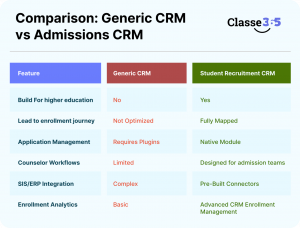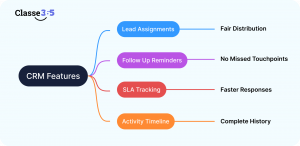Understanding Student Information Systems in Modern Education
In modern education, Student Information Systems (SIS) have become a cornerstone. These systems, often referred to as SIS software or student management systems, are transforming schools and educational institutions around the world. This article explores the future of these systems and their relevance to the evolution of educational technology.
What a Student Information System Really Does Today
Modern SIS platforms manage student lifecycles from end to end. From admissions to academics, attendance, communication, and alumni management, everything is centralized. The integration of a student information management system ensures administrators, teachers, and parents work within one unified ecosystem.
Many institutions also combine SIS with a pre-admission enrolment to simplify registrations and reduce manual processes.
Role of Management Information System (MIS) in Schools
MIS systems support data processing and administrative decisions. They handle institutional-wide information flows that go beyond student data, attendance software, including HR, compliance, facilities, and resource allocation.
How SIS and MIS Work Together to Power Institutions
The integration of SIS and MIS systems has resulted in an ecosystem that not only eliminates data redundancy but also enhances the quality of reporting. Through the use of an online attendance management system, the institutions are able to trace the attendance of the students, keep an eye on the academic activities, predict the trends, and make quick decisions based on the data.
How a Student Information System Works (Complete Breakdown)
Data Collection & Digital Records Management
SIS is a centralized academy management software which database like academic records, attendance, behavior logs, health information, and more, reducing paper-based processes and enabling real-time data access.
Secure SIS Login & Role-Based Access
Administrators, teachers, parents, and students access information through secure, permission-based logins to maintain transparency while protecting sensitive data.
Automation of Daily Tasks (Attendance, Grading, Timetables)
SIS platforms automate routine operations such as:
- Online attendance tracking
- Gradebook entry
- Timetable creation
- Assignment record-keeping
This improves accuracy and reduces administrative workload.
Communication Tools for Parents, Teachers, and Students
Built-in communication modules enable messaging, reminders, behavioral alerts, circulars, and announcements—strengthening engagement.
Reporting, Dashboards & Analytics Through EMIS Systems
SIS systems integrate with EMIS (Education Management Information Systems) to provide dashboards for:
- Academic performance
- Attendance analytics
- Fee collection reports
- Compliance documentation
Key Features of Student Information System (2025 Edition)
Student Enrollment & Online Registration
A modern Student Information System digitizes the entire admissions journey, from form fill-up and document upload to automated verification. This reduces queues, manual errors, and repetitive data entry for administrators.
Real-Time Attendance Tracking & Online Attendance Management System
Attendance is captured through biometric devices, RFID cards, mobile apps, or web check-ins. The SIS instantly updates dashboards, enabling teachers and administrators to monitor attendance trends with ease.
Gradebook Automation, Assessments & Digital Report Cards
Teachers can record grades digitally, manage assessments more efficiently, and generate standardized, error-free report cards within minutes. Automated calculations, assessment rubrics, and performance analytics help ensure accuracy while reducing repetitive manual work for educators.
Timetable & Class Scheduling Automation
SIS tools generate intelligent timetables that avoid clashes, optimize teacher workload, and support hybrid classes. Schools save hours of manual scheduling effort every term.
Fee Management & Online Payments
Integrated fee management software enables invoice creation, payment reminders, online payment collection, and automated reconciliation. This reduces administrative pressure and enhances financial transparency.
Parent and Student Portals
Portals serve as single access points for academic progress, assignments, attendance, fee updates, and announcements. Parents stay informed effortlessly, improving communication and involvement.
Teacher Information System & Staff Management
Schools can maintain digital profiles for each staff member, track workload, manage schedules, and record leave or performance data. This supports better workforce planning.
Communication & Notification Tools
Built-in email, SMS, and app notifications ensure that parents, teachers, and students receive updates in real time. Institutions can send alerts instantly without relying on external tools.
Data Security, Access Control & Compliance Tools
Role-based access, encryption, and audit logs help protect sensitive information. SIS systems support compliance with academic boards, accreditation bodies, and institutional policies.
Benefits of Implementing a Student Information System in Schools
Centralized Data for Administrators, Teachers, and Parents
All student information, from academics to attendance, is stored in one place. This eliminates scattered systems and improves operational clarity.
Higher Efficiency Through Automation
Automation of routine tasks dramatically reduces paperwork and minimizes human error. Staff gain more time to focus on teaching and student growth.
Real-Time Performance Tracking & Insights
Visual dashboards highlight performance trends, attendance patterns, and high-risk indicators. Administrators can make data-backed decisions instantly.
Improved Parent Engagement & Transparency
Parents get real-time access to school updates, academic reports, and attendance logs, ensuring they stay actively involved in their child’s learning journey.
Enhanced Data Security
Encrypted storage and secure access protocols protect student data from unauthorized access. Schools can maintain digital records confidently without compromising privacy.
Compliance with Boards & Accreditation Needs
SIS platforms maintain structured records that simplify audits and reporting for educational authorities. This ensures institutions meet regulatory standards easily.
Scalability for Multi-School & Growing Institutions
Whether you manage a single campus or multiple branches, SIS platforms scale effortlessly, adapting to new programs, classes, or operational needs.
Why Your School Needs a Student Information System Today
Replace Manual Workflows with Smart Workflows
Digitization simplifies administrative processes and eliminates repetitive tasks. Schools can operate more efficiently with automated systems.
Support Hybrid & Digital-Classroom Environments
An SIS connects online and offline learning, making it easier to manage virtual classes, digital assignments, and hybrid schedules.
Improve Accountability Across Departments
Every action, attendance updates, fee entries, and grade submissions, is logged and traceable. This encourages responsibility and reduces discrepancies.
Achieve Better Learning Outcomes Through Data
Teachers gain insight into student performance trends, enabling targeted interventions and more personalized learning strategies.
Types of Institutions That Benefit from SIS Software
Preschools & Early Learning Centers
They can track attendance, health records, fees, and parent communication digitally, providing a safe and transparent environment for young learners.
K–12 Schools
K–12 institutions use SIS for timetables, examinations, classroom management, and behavior tracking, all in one unified system.
Colleges & Universities
Higher education institutions benefit from advanced workflows, credit-based systems, transcripts, and seamless LMS integration.
International & Multi-Branch Institutions
Centralized dashboards allow leadership teams to monitor performance, compliance, and operations across global campuses in real time.
Vocational, Skill Centers & Online Learning Platforms
These institutions rely on digital classrooms, online assessments, and real-time outcome tracking to manage students effectively.
Future of Student Information Systems – What’s Next?
AI-Based Personalization & Predictive Analytics
AI tools will analyze performance, attendance, and behavior patterns to predict risks and personalize learning paths for students.
Cloud-Based SIS Platforms with Mobile-First Access
Cloud-hosted systems enable anytime, anywhere access while reducing IT overhead and improving data security.
Unified Campus Information System Integrations
Future SIS solutions will integrate seamlessly with ERP, LMS, CRM, HRMS, accounting, and EMIS platforms for complete campus automation.
Advanced Communication Ecosystems (Students + Teachers + Parents)
Next-gen SIS will offer real-time collaboration channels that go beyond notifications, supporting chats, forums, and classroom engagement tools.
How to Choose the Right Student Information Management System
Must-Have Features for 2025 & Beyond
Look for automation, analytics, mobile-first design, LMS integration, and compliance tools to future-proof your institution.
Mobile Apps & Cloud Infrastructure
Mobile access ensures convenience, while cloud hosting provides scalability and cost efficiency for institutions of all sizes.
Integration with LMS, ERP, and School Attendance Software
Seamless integrations eliminate data silos and enable schools to manage academics, operations, and finance within single ecosystem.
Data Privacy, Security, and User Roles
Choose an SIS with encryption, secure user access, and customizable roles to protect sensitive data and maintain compliance.
Customization & Scalability for Growth
Institutions should prioritize flexible modules that can expand with new branches, programs, and operational needs.
FAQ
What is a Student Information System (SIS)?
A Student Information System (SIS) is a software application that allows educational institutions to manage student data. It provides capabilities for registering students in courses, documenting grading, transcripts, and test results, building student schedules, tracking student attendance, and managing many other student-related data needs in a school.
What are the benefits of using a Student Information System?
The benefits of using a Student Information System include improved student data management, efficient student tracking systems, and enhanced communication between educators, students, and parents.
How does an SIS differ from a traditional Student Management System?
While both systems are designed to manage student data, an SIS offers more advanced features, including integration with other campus information systems, advanced student tracking capabilities, and enhanced student data management tools.
What are some key features to look for in an SIS software?
Key features to look for in SIS Software include robust student tracking systems, integration capabilities with other campus information systems, and enhanced student data management tools.
What are the challenges of implementing a Student Information System?
Challenges of implementing a Student Information System can include data migration issues, user training, system customization, and integration with existing systems.
How is artificial intelligence being integrated into Student Information Systems?
Artificial intelligence is being integrated into Student Information Systems in several ways, including automating routine tasks, providing predictive analytics, and offering personalized learning recommendations.
What is the future of Student Information Systems in education?
The future of Student Information Systems in education is likely to be shaped by advancements in technology such as artificial intelligence and cloud computing. These technologies can help automate tasks, provide predictive analytics, and offer personalized learning recommendations.
Can small schools use SIS software?
Absolutely. Cloud-based and even free student information system options allow small schools to implement digital workflows without heavy investment.
Is there a free student information system available?
Yes, several platforms offer basic free SIS versions for small institutions, often covering attendance, grades, and parent communication.
How does SIS improve parent engagement?
Parents receive real-time updates on grades, attendance, assignments, and school communication, helping them stay informed and actively participate in their child’s education.


